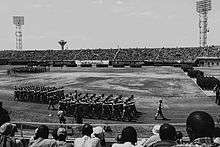Amahoro Stadium
 | |
| Full name | Amahoro Stadium |
|---|---|
| Location | Kigali |
| Owner | Government of Rwanda |
| Capacity | 30,000[1] |
| Surface | Grass |
| Construction | |
| Built | Habyarimana Juvenal government |
| Opened | 1986 |
| Main contractors | China Civil Engineering Construction Corporation |
| Tenants | |
| Rwanda National Team | |
The Amahoro Stadium (Kinyarwanda: Stade Amahoro;[2] French: Stade Amahoro;[3] Kinyarwanda for "Peace Stadium"), also known as Amahoro National Stadium,[2] is a multi-purpose stadium in the Gasabo district of Kigali, Rwanda. With a capacity of 30,000,[1] it is the largest stadium in Rwanda and hosts football matches, concerts, and public events. The football clubs Armée Patriotique Rwandaise F.C. and Rayon Sports F.C. are the tenants. The venue is also sometimes used for rugby union.
During the Rwandan Genocide in 1994, it was temporarily a "UN Protected Site" hosting to up to 12,000 mainly Tutsis refugees.
History
The stadium was constructed by the China Civil Engineering Construction Corporation, at a cost of US$ 21 million.[4] Construction began in March 1984, and was completed in January 1989.[5]
In 1990, the Rwandan Civil War broke out between the Rwandan Patriotic Front (RPF), a Tutsi rebel group, and President Juvenal Habyrarimana's government forces.[6] The war ended in 1993 with a cease-fire and the signing of the Arusha Accords, which gave the RPF positions in a Broad-Based Transitional Government (BBTG) and the national army, and also provided for a United Nations peacekeeping force.[7][8] This force was known as the United Nations Assistance Mission for Rwanda (UNAMIR), and was headed by Canadian general Roméo Dallaire.[9] UNAMIR's initial headquarters was in the Hotel des Mille Collines, but the upmarket hotel did not welcome the presence of soldiers, and Dallaire quickly sought an alternative location;[10] after some days of searching, UNAMIR chose the Amahoro Stadium, which was large enough to host an entire batallion of soldiers.[11] The headquarters was opened on 17 November 1993, with an official ceremony attended by Dallaire and President Habyarimana.[12]
The cease-fire ended abruptly on 6 April 1994 when Habyarimana's plane was shot down and he was killed;[13] the assassination served as the catalyst for the Rwandan Genocide, which began within a few hours. The interim government began killing Tutsi and politically moderate Hutu, in well-planned attacks across the country.[14] Tutsi civilians began seeking refuge in United Nations premises, and thousands of refugees gathered inside the Amahoro Stadium.[15]
References
- 1 2 Mutale, Chama (7 January 2016). "Uganda/Zimbabwe: Zambia to Face Zimbabwe, Uganda At Umuganda Stadium". Zambian Watchdog.
- 1 2 "UMUSHINGA WO GUTUNGANYA STADE AMAHORO URI MURI GAHUNDA". Ministry of Sports and Culture.
- ↑ Kalfa, David (15 January 2016). "Chan 2016: pas d'entraînements au Stade Amahoro". Radio France International (in French).
- ↑ "UMUSHINGA WO GUTUNGANYA STADE AMAHORO URI MURI GAHUNDA" (PDF). The China Analyst.
- ↑ "卢旺达国家体育场项目". China Civil Engineering Construction Corporation (in Chinese).
- ↑ Prunier 1999, p. 93.
- ↑ Prunier 1999, pp. 190–191.
- ↑ Prunier 1999, p. 187.
- ↑ Moore 1998, p. 318.
- ↑ Dallaire 2005, p. 106.
- ↑ Dallaire 2005, p. 109.
- ↑ Dallaire 2005, pp. 109 110.
- ↑ BBC News (12 January 2010). "Hutus 'killed Rwanda President Juvenal Habyarimana'". London. Retrieved 10 November 2015.
- ↑ Dallaire 2005, p. 386.
- ↑ The Rwanda Focus (8 July 2015). "The tale of two brave, heroic RPF Inkotanyi battalions".
Cited works
- Dallaire, Roméo (2005). Shake Hands with the Devil: The Failure of Humanity in Rwanda. London: Arrow. ISBN 9780099478935.
- Moore, Jonathan (1998). Hard Choices: Moral Dilemmas in Humanitarian Intervention. Rowman & Littlefield Limited. ISBN 9780847690312.
- Prunier, Gérard (1999). The Rwanda Crisis: History of a Genocide (2nd ed.). Kampala: Fountain Publishers Limited. ISBN 9789970020898.
Coordinates: 1°57′18.1″S 30°6′51.2″E / 1.955028°S 30.114222°E